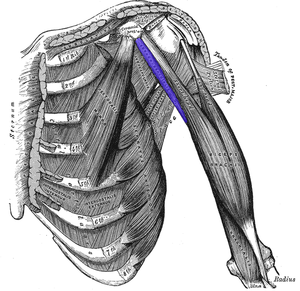Coracobrachialis Muscle: Difference between revisions
No edit summary |
No edit summary |
||
| Line 29: | Line 29: | ||
It is innervated by musculocutaneous nerve which pierces it. | It is innervated by musculocutaneous nerve which pierces it. | ||
== | == Clinical Relevance == | ||
The nutrient foramina of the humerus is located at the region of insertion of this muscle to the humerus. | |||
Symptoms such as pain in the shoulder and arm going down the posterior part of the hand is most likely be due to calcification or hardening of coracobrachialis, occurring as a result of overuse and carrying of heavy weight. | |||
Musculocutaneous nerve entrapment can occur. Patients show elbow flexor( [[biceps brachii]] and [[brachialis]]) weakness and impairment in skin sensation on the lateral part of the forearm. | |||
== | == Assessment == | ||
== References == | == References == | ||
<references /> | <references /> | ||
Revision as of 15:39, 20 February 2019
Original Editor Uchechukwu Chukwuemeka
Top Contributors - Uchechukwu Chukwuemeka and Kim Jackson
Description[edit | edit source]
Coracobrachialis muscle is one of the three muscles that originates from to the coracoid process of the scapula. It is situated at the superomedial part of the humerus[1].
Origin[edit | edit source]
Apex of the coracoid process, in between the pectoralis minor and short head of biceps brachii muscle
Insertion[edit | edit source]
Its tendon attaches to the linear impression at the medial side of the midshaft of the humerus
Function[2][1][edit | edit source]
At the glenohumeral joint, the coracobrachialis
- flexes and adducts the humerus.
- acts as humeral head stabilizer together with the deltoid and long head of the triceps brachii.
- assists in arm internal rotation
Blood Supply[edit | edit source]
It's blood supply is by a branch of the brachial artery.
Innervation[edit | edit source]
It is innervated by musculocutaneous nerve which pierces it.
Clinical Relevance[edit | edit source]
The nutrient foramina of the humerus is located at the region of insertion of this muscle to the humerus.
Symptoms such as pain in the shoulder and arm going down the posterior part of the hand is most likely be due to calcification or hardening of coracobrachialis, occurring as a result of overuse and carrying of heavy weight.
Musculocutaneous nerve entrapment can occur. Patients show elbow flexor( biceps brachii and brachialis) weakness and impairment in skin sensation on the lateral part of the forearm.







